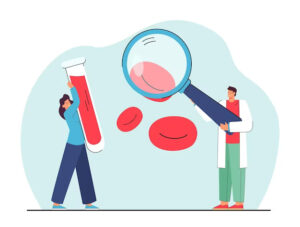When there are fewer red blood cells in your blood for Anemia, it is more difficult for oxygen to be transported from your lungs to the rest of your body. This condition is known as anemia. Anemia risk is higher in those with cancer, autoimmune diseases, or heavy menstrual cycles.
Typically, vitamins or drugs that promote the production of more red blood cells in your body are used to treat anemia. You might require intravenous medication, a blood transfusion, or possibly surgery if your anemia is more severe.
Extreme fatigue and drowsiness
The most prevalent sign of anemia caused by a lack of iron is feeling tired or exhausted. Additionally, hemolytic anemia and aplastic anemia are linked to the condition.
The body needs oxygen for energy, and red blood cells carry oxygen throughout the body. Your body’s tissues and muscles cannot get enough oxygen or energy if your red blood cell count is low.
Additionally, to circulate the oxygen-rich blood you do have throughout your body, your heart is working harder than usual. Extreme fatigue and exhaustion might result from the culmination of all of these factors.
White Skin
In all forms of anemia, pale skin is typical. Blood flow is associated to paleness. Red blood will flow to the surface less when you have less red blood cells, which will result in some color loss in your skin.
One of the first things a doctor will check for when diagnosing anemia is pale skin.
Paleness might be present all over the body or only in one location. Paleness on the nails, hands, and eyelid lining may be particularly noticeable in anemic people.
Headaches
Numerous types of anemia are associated with headaches, and occasionally migraines, although the cause of this is yet unknown. There is some data that suggests the primary cause of the headaches may be iron deficiency, the most common form of anemia. This might be especially true for females, especially during menstruation.
Idiopathic intracranial hypertension, a disorder in which elevated pressure around the brain causes headaches among other symptoms, is also thought to be at risk due to anemia. Adult obese women are more likely to suffer from this rather uncommon illness.
Breath Control Issues
Your oxygen levels are low during anemia because hemoglobin, a protein in red blood that delivers oxygen, is low. Your muscles and tissues are thus being deprived of blood that is rich in oxygen.
When this occurs, simple tasks like making the bed or even just walking or climbing stairs can become more difficult. You might have breathlessness and occasionally feel woozy or lightheaded.
It’s crucial to consult a doctor as soon as possible if you frequently feel out of breath. Breathing issues may indicate a significant medical condition in addition to anemia, which is a marker of shortness of breath.
Palpitations or an irregular heartbeat
The body can better distribute oxygen thanks to hemoglobin. Low hemoglobin levels brought on by anemia might make it difficult for your heart to pump blood and carry oxygen.
Your heart may experience irregular heartbeats as a result of this added stress, as well as the sensation that it is beating too quickly or unnaturally.
Changes in Hair, Skin, and Nails
Koilonychia, a nail deformity, could be brought on by anemia. This disorder, which is characterized by thin, brittle, and spoon-shaped nails, is usually seen in people who have chronic iron insufficiency.

Given that low oxygen levels can result in dryness and fatigue, anemia may also be associated with hair loss and dry skin. You might observe that your hair is not growing or that you are losing more hair than usual if you have iron-deficiency anemia.
It’s crucial to consult a healthcare professional if you observe a change in your skin, hair, or nails. The changes could indicate a different medical problem even if they are unrelated to anemia.
A swollen or sore tongue
Anemia can occasionally show symptoms on your tongue or on the inside of your mouth. For instance, one study discovered that 76% of individuals with iron-deficiency anemia experienced mouth burning.
The participants in the same study also mentioned irritation, dry mouth, and a smooth, pale, and swollen tongue.16 Mouth ulcers and painful, red splits at the corners of the mouth are additional probable anemia signs.
Nerve Injury
You may develop nerve damage if you have pernicious anemia, which is brought on by a vitamin B12 deficiency. Your hands and feet may become tingly and numb as a result of this damage.
You can also lose your reflexes and develop muscle weakness as a result of the nerve injury. This may cause you to feel shaky on your feet, experience balance problems, and find it difficult to walk.
Symptoms of Anemia in Children
Due to their rapid growth and increased need for iron, children and newborns are more susceptible to iron deficiency anemia. Anemia can be brought on by eating a diet that is too low in iron or by drinking a lot of dairy milk, both of which can affect how well iron is absorbed.
Child and newborn anemia symptoms include:
- Tiredness
- Breathlessness
- Unusual appetite loss or food cravings
- Irritability
- Migraines or vertigo
- Bruised tongue
- Paleness
- Extremely pale or blue-tinged eye whites
- Cracked nails
When to Consult a Medical Professional
It’s crucial to see a healthcare professional if you are exhibiting any of the aforementioned symptoms. Even seemingly innocuous symptoms like fatigue and headaches might be a warning of more severe anemia because mild to moderate anemia cases are frequently asymptomatic.
Anemia can have major side effects, such as organ failure and the deterioration of other illnesses like cardiovascular disease, if it is not addressed.

Anemia-related symptoms should be discussed with a healthcare professional by expectant women as well. Premature birth, low birth weight, and a higher risk of anemia in the infant are all possible effects of the illness.
To determine whether you have anemia or another medical problem, a healthcare professional can provide a diagnosis. From there, they can choose a course of therapy that is appropriate for you.
A Brief Overview
Red blood cells in your blood are less abundant when you have anemia. This can lessen the quantity of oxygen that is carried from your lungs to the rest of your body since red blood cells carry oxygen.
Anemia can cause fatigue, pallor, and breathing difficulties. The hair, skin, and nails may also change for some people, along with headaches, heart palpitations, and other symptoms.
Speak with your healthcare professional if you have any anemia-related symptoms. They can help you seek therapy and determine whether you have the illness.



